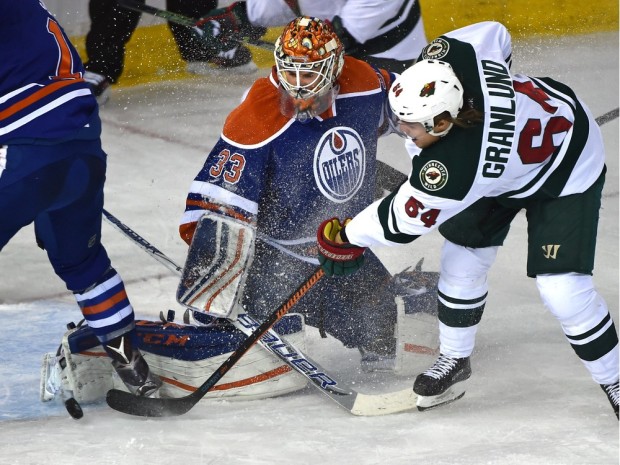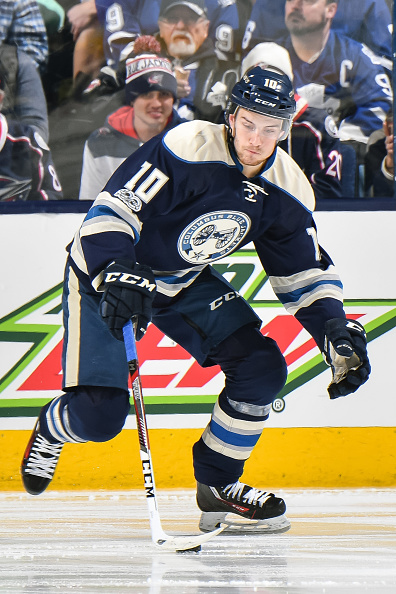Two years ago, the Minnesota Wild and the St. Louis Blues squared off in the first round of the NHL playoffs, with the Wild, who finished the regular season nine points behind, upsetting in six games a Blues team with eyes set on the Stanley Cup. Entering the 2017 playoffs, the roles were reversed, with the Wild, fresh of pushing forward all their chips at the trade deadline, expecting a long spring campaign and the underdog Missourians determined to crash their party.
Funny enough, former Wild coach Mike Yeo also exchanged benches in the meantime, and he played his part to once again shake hands for the winning side as St. Louis exacted their small revenge to book a place in the second round. How did they manage it?
Series Results:
Game 1: St. Louis Blues 2 @ 1 Minnesota Wild (OT)
Game 2: St. Louis Blues 2 @ 1 Minnesota Wild
Game 3: Minnesota Wild 1 @ 3 St. Louis Blues
Game 4: Minnesota Wild 2 @ 0 St. Louis Blues
Game 5: St. Louis Blues 4 @ 3 Minnesota Wild (OT)
Jake Allen bested Devan Dubnyk
In his first NHL season as St. Louis’ undisputed starter, Jake Allen went through hell in the winter before finding his footing in March, arriving at the postseason on the crest of a 0.942 Sv% amassed over his last fifteen games. Truth be told, the Blues benefited from a soft schedule late and few believed Allen would maintain such a hot streak, yet he flat-out stole Game 1 in Minnesota with a 51-save performance and then kept frustrating the Wild for the rest of the series.
Over five games, the 26-year-old posted a superlative 0.956 Sv% and 1.47 GAA, marks that ranked second amongst his peers in the first round, and captured a series win his team had no business picking up. Not only because Minnesota significantly outplayed St. Louis in four of five matches, but also because his counterpart Devan Dubnyk put together an unappreciated effort that went to waste.

Jake Allen gobbles the puck on another Minnesota Wild chance in Game 2 (Photo by Hannah Foslien/Getty Images)
The Wild’s All-Star goaltender, who hit a rough patch late in the regular season, concluded the series with excellent numbers (.925 Sv% and 1.86 GAA) but he just couldn’t touch the same high notes as Allen. For example, at even strength, both men allowed one goal on low-danger shots and two on medium-danger opportunities, yet Allen blocked 23 of 24 (0.958 Sv%) high-danger chances whereas Dubnyk let in 4 of 20, sinking his EV Sv% to 0.911, fifty-seven points below Allen’s stellar 0.968.
Thus, it wouldn’t matter that Dubnyk stood close to perfection when the Blues were on the powerplay, deflecting 26 of 27 shots, as the one that snuck through went down as the game-winner in Game 2. So harsh can be the life of a goaltender come playoff time…
No Shattenkirk, no problem
With 19 points obtained in 26 playoff games over the last two postseasons, Kevin Shattenkirk was a major cog of St. Louis’ defence up to the deal that sent him to the Washington Capitals. While Doug Armstrong’s hand was forced by the need to recoup some assets, his absence represented a major drawback to the Blues’ chances this spring, and they needed someone to pick up the slack, especially five-on-five.
Cue the Blues second defensive pair, composed of sophomores Joel Edmundson and Colton Parayko. Mobile, large, strong and, in this series, effective on both sides of the puck, the duo did a commendable job stepping up to the challenge. The less heralded Edmundson scored the OT winner in Game 1 and later broke the ice in Game 2, posting a series-high +6 and 16 blks in 22:10 min TOI/GP. As for the 22-year-old Parayko, he opened the scoring in Game 3 and set up Alex Steen for the Blues’ second goal in Game 5, skating to a +4 with 14 SOG and 13 blks in vital 24:44 min TOI/GP.

It wasn’t always pretty, but Parayko and company found a way to keep the puck away from their net. (Photo by Bruce Kluckhohn/NHLI via Getty Images)
Much like the majority of St. Louis’ players, it’s fair to point out they got plastered five-on-five in terms of possession (39.7 adj. CF%), but the pair still came out on the positive side in Scoring changes for (6-5) and, naturally, goals (4-0), while the same can’t be said for the Blues No.1 pairing, as Alex Pietrangelo and Jay Bouwmeester amassed a 37.0 adj.CF% and bled scoring chances (5-9).
Parayko and Edmundson accounted for a 111 PDO, which means they’re bound to regress hard – probably already against the Predators – but, for now, they’ve rewarded Mike Yeo’s confidence.
Bruce Boudreau tinkered his forwards lines incessantly but couldn’t find the winning combination
The Minnesota Wild manufactured 3.21 goals per game during the regular season, second best in the NHL, but those numbers don’t necessarily portend they possess a surplus of firepower up front. Bruce Boudreau’s team lacked a 30-goal scorer or a 70-pts player, and boasted just two forwards (Mikael Granlund (69) and Eric Staal (65)) niched inside the list of top 50 point getters. In other words, they lack the game-breakers that usually come in handy at playoff time and against an inspired Jake Allen that deficiency proved fatal.
The Wild mustered just 8 goals in the equivalent to five and a half games of hockey, and only Zach Parise and Charlie Coyle accrued two points at even-strength. The Wild’s top nine forwards in Game 1 were staggered in an All-Finnish line with Erik Haula, Mikko Koivu and Mikael Granlund, a Zach Parise – Eric Staal – Nino Niederreiter combination, and the duo Jason Zucker and Charlie Coyle flanking Martin Hanzal, but it didn’t stay that way for long as Bruce Boudreau cranked up the blender in a hurry.

Martin Hanzal rams through Jake Allen in Game 3, but to no effect. (Photo by Dilip Vishwanat/Getty Images)
For Game 2, Zucker returned to the left of Koivu and Granlund to try to rekindle the magic of the regular season, while Niederreiter was dropped to the fourth line to make room for Charlie Coyle. Then, in Game 3, Haula was moved to centre between Jason Pominville and Chris Stewart, with Niederreiter joining Hanzal, but nothing seemed to juice up the offense.
Down 3-0 in the series, Boudreau separated the Granlund/Koivu and Parise/Staal duos and connected Pominville, Hanzal and Zucker, who scored in the Wild’s win. You don’t change what’s working, right? Nope. In Game 5, the wheel kept spinning, with Parise alongside the reunited Koivu and Granlund up to the moment Eric Staal left the game injured. After that, more reshuffling, obviously. And, soon after, the Blues closing the series in overtime.
All things considered, despite controlling the puck (58.9 adj. CF%) like no other team in the first round, averaging 9.6 more SOG per game (36.4 to the Blues 26.8), and slugging to a 55.1 adj. SCF%, the Wild scored just five even strength goals – one with Dubnyk pulled – and registered a single forward line who logged more than 20 minutes together. Jake Allen’s brilliance may have been the major reason for the Wild’s demise, but Bruce Boudreau’s actions didn’t help.
Best players in the series
Jake Allen (St. Louis Blues)
For the reasons exposed above, Jake Allen was the X-factor for St. Louis in the series, yet forward Jaden Schwartz deserves an honourable mention. The 24-year-old picked up a series-high 5 pts (2+3), and his contributions encompassed the game-winners in Game 2 and 3, three shots on goal per game, 22 min TOI/GP – tops among Blues forwards – and respectable underlying metrics. In fact, Schwartz and linemate Vladimir Tarasenko were the only Blues’ forwards simultaneously above 44.0 adj. CF% and 54 adj. SCF%.

Jaden Schwartz is about to blow the puck past Devan Dubnyk to give the Blues victory in Game 2 (Photo by Bruce Kluckhohn/NHLI via Getty Images)
Mikael Granlund (Minnesota Wild)
Without standout Minnesota Wild performances in the series, left winger Zach Parise – 3 pts (1+2), including the late goal to tie Game 1 – wouldn’t be a terrible choice here. However, he also accounted for a -4 rating and 4 minor penalties, therefore I’ll appoint Mikael Granlund. Minnesota’s best forward during the regular season struggled to make an impact on the scoresheet, collecting just 2 assists in 5 games, but he still looked dangerous at most times, impacting the play with a massive 85.1 adj. SCF% (1st on the team) and excellent 63.1 adj. CF% (4th).
Will the Minnesota Wild return to the playoffs next year?
Boudreau’s teams have always turned into regular season juggernauts, so you can safely bet on that. However, Minnesota’s long-term prospects don’t look good with Ryan Suter (32) and Zach Parise’s (soon to be 33) contracts running until 2071 (approximately) and age clearly catching up to them.
Dubnyk and most of the defensive core have contracts with a few years left, providing cost certainty in the near future, which is exactly why 22-year-old Matt Dumba (RFA in 2018) may have to be sacrificed in the expansion draft instead of Marco Scandella (UFA 2020) or Jonas Brodin (UFA 2021). In a perfect world, they would rather ditch 34-year-old forward Jason Pominville – whose 5.6M deal until 2019 looms large – yet his NTC/NMC prevents that.
The Wild have 15 players signed for next season and 11.4 M in cap space, but most will be absorbed by the contract extensions of RFA’s Mikael Granlund and Nino Niederreiter. In a conservative estimative, the Wild should assume their raises will trim that number to less than 3M, which won’t be enough to bring back 30-year-old Martin Hanzal, in line for a healthy increment from his current 3.1 M cap hit. And they can’t bring back the valuable picks they forfeited for his five playoff games either…
*For an explanation of the “advanced statistics” terminology cited on this article, read Corsica’s glossary. Unless stated otherwise, all data refers to 5-on-5 play and was retrieved from Corsica.hockey (currently down), Natural Stat Trick and NHL.com.

Maybe the Minnesota Wild will have more reasons to celebrate next season (Photo by Bruce Kluckhohn/NHLI via Getty Images)


















